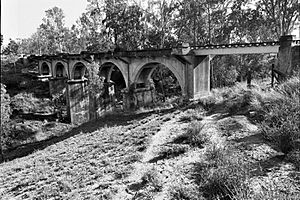Steep Rocky Creek Railway Bridge facts for kids
Quick facts for kids Steep Rocky Creek Railway Bridge |
|
|---|---|

Steep Rocky Creek Railway Bridge
|
|
| Location | Mungar - Monto railway line, Ideraway, North Burnett Region, Queensland, Australia |
| Design period | 1900 - 1914 (early 20th century) |
| Built | 1906 - 1907 |
| Architect | William Pagan |
| Official name: Steep Rocky Creek Railway Bridge (Ideraway) | |
| Type | state heritage (built) |
| Designated | 21 October 1992 |
| Reference no. | 600520 |
| Significant period | 1900s (fabric) |
| Significant components | abutments - railway bridge, pier/s (bridge) |
| Lua error in Module:Location_map at line 420: attempt to index field 'wikibase' (a nil value). | |
The Steep Rocky Creek Railway Bridge is a very old and special bridge in Queensland, Australia. It's located in a place called Ideraway, on the railway line that goes from Mungar to Monto. This bridge was designed by a clever engineer named William Pagan. It was built between 1906 and 1907. It's so important that it's listed on the Queensland Heritage Register. This means it's protected because of its history and unique design.
Building This Special Bridge
Building the railway line from Wetheron to Gayndah started in March 1906. Workers were paid by the day for their hard work.
The area around Deep Creek was tricky to build on. There were two deep gorges between Ideraway and Gayndah. These gorges needed special bridges. The Steep Rocky Creek Bridge was one of them. The other was the Ideraway Creek Railway Bridge.
The plans for this bridge were signed by the Chief Engineer, William Pagan. He made sure the bridge could hold the heaviest trains of that time. Mr. Pagan also watched over the building work on site. The bridge was finished in 1907. The railway line opened for trains on December 16, 1907.
What the Bridge Looks Like
The Steep Rocky Creek Bridge is made up of several parts. It has one section that is about 26 feet long. This part uses three strong metal beams called RSJs (which stands for Rolled Steel Joists).
Next, there are five concrete arches. Each of these arches is about 28 feet long. Arches are curved structures that help support the bridge.
Finally, there's another 26-foot section with three more RSJ beams. All these parts are held up by six strong concrete piers. Piers are like big columns that support the bridge from below. The bridge also has two abutments. These are the parts that connect the bridge to the land on each side.
Why This Bridge is Special
The Steep Rocky Creek Railway Bridge was added to the Queensland Heritage Register on October 21, 1992. This means it's recognized as an important historical site.
Here's why it's considered so special:
- It shows how Queensland's history changed. The bridge has a very new and smart design for its time. It uses reinforced concrete arches that were a bit different from others. It was the first bridge of its kind in Australia with this specific design. It was also only the fifth concrete arch railway bridge ever built in Australia.
- It shows great skill and new ideas. The bridge's design was very advanced for when it was built. Its special reinforced concrete arches were a big step forward in bridge building.
- It's linked to an important person. The bridge is connected to Chief Engineer William Pagan. He was a very important person in Queensland's history of building railways.

